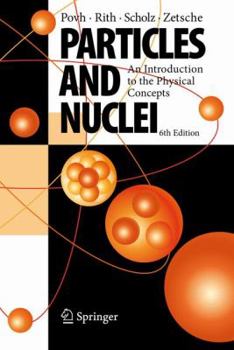Particles and Nuclei: An Introduction to the Physical Concepts
Select Format
Select Condition 
Book Overview
This concise text is based on lectures held at the University of Heidelberg and is well suited for undergraduate courses. It includes numerous exercises with worked answers. This description may be from another edition of this product.
Format:Paperback
Language:English
ISBN:3540793674
ISBN13:9783540793670
Release Date:January 2008
Publisher:Springer
Length:400 Pages
Weight:1.40 lbs.
Dimensions:0.9" x 6.3" x 9.3"
Customer Reviews
3 ratings
As bought from the bookshop
Published by Thriftbooks.com User , 15 years ago
It arrived to me in Italy 20-15 days before the standard international shipping's time, in perfect conditions, as bought from the bookshop.
An extremely satisfying presentation!
Published by Thriftbooks.com User , 16 years ago
This book was an eye-opening discovery to me. I was introduced to another book at my American college-- Perkins: "Intro to High Energy Physics". Want a fine reference book for your shelf? Get Perkins. Want to actually *learn* the subject? Get THIS book by Povh et al! What I like: - First, it accomplishes an amazing presentation task. The subject area itself is somewhere between graduate level and not-even-solved active research (eg quark theory). Yet it manages a presentation that is readable at the undergraduate level. - It is a relatively short and punchy presentation. It presents a small number of cases per topic that have the most instructive physics; and within those cases it often focuses on simple, memorable extremes. A lot of thought and refinement must have gone into this! This is great for learning, since I think we humans learn and retain things that are simple and extreme. - The text is full of teaching and applying *physical intuition*. My MasterCard commercial: "Physics text brimming with formulas: $70. Intuition: Priceless." - Why I find this book so satisfying: When you got into science in the first place, didn't you have those visceral curiosities, like "just how big is this body compared to that?", or "what is its shape?"? This book addresses that in a satisfying way. In addition to it being thoughtfully illustrated, the text seems to strive to connect measured things, eg Fourier components, back to a tangible description. - I'm grateful to its teaching me about the nuclear regime. Since sub-nuclear fundamental particles have been the sexy forefront forever, the nucleus doesn't seem to get much airtime. But including it makes a nice story, with analogies that connect the atomic, nuclear, and subnuclear regimes. - Lastly: It presents experimental data, much of it through reproduced original graphs and data. So this is a book about reality. In any case, I see tons of care, care, care, and attention to the student. Back to the comparison with Perkins. I think Perkins is fine, and I've even updated to its 4th edition. But in comparison to what this book (Povh et al) proves can be accomplished, Perkins is more like a technical summary of current results rather than something I would recommend curling up with and enjoying learning everything from. So to new students: I hope you discover this book. To new course designers: I hope you help your students with great examples of teaching like this!
Up to date and State of the art
Published by Thriftbooks.com User , 23 years ago
Povh, Rith, Scholz, and Zetsche have written an exceptional book about nuclei and particles. It is comprehensive, but not too elaborate to confuse the reader, it is up to date, but provides a thorough guide to the contemporary topics, and it has an unusual structure that is very compelling: In part one, the decomposition of matter down to the structures of elementary particles is presented, in part two, the synthesis of composite systems out of these fundamental particles and their interactions is discussed. This approach is - from a structural point of view - a brilliant idea.So why do I rate this book with 4 stars only? Maybe because I personally like Donald Perkins' book on high-energy phyics even better (and if the new edition is as good as announced it will probably remain my preferece). The nuclear physics content (my personal field of interest) is also only briefly addressed in the book by Povh et al. (Perkin's book of course contains no introduction to nuclear structure at all, even on a very rough scale, but it has its focus clearly only on high-energy physics whereas Povh et al. also address nuclear structure issues). Clearly, Povh et al. focus on the introduction to a wide field where addtional reading is required anyway.It would be highly desirable if the authors could enlarge their interesting introductory textbook by a few topical results of nuclear structure physics. But all in all, it is a very good approach to the world of nuclei, particles, and their interactions.





